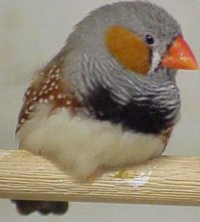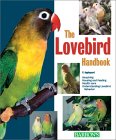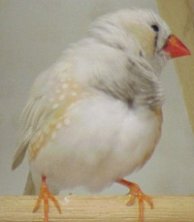Zebra Finches
An Interview with Garrie Landry, who breeds exhibition-quality Zebra Finches. He has over 30 varieties of zebra finch in his aviary. Visit the Acadiana Aviaries website to see photographs of his beautiful birds.
What should a beginner specifically look for in these birds when selecting initial breeding stock for exhibition-quality zebra finches?
Size is important and perhaps most important, as it is more difficult to increase size if it is not there to begin with. Conformation and carriage are equally important but these too can be dealt with after size. If sizeable birds are available, then among them look for birds that have a good shape and good stance. Choose those with the best markings too, such as males with a prominent breast bar and females that have no extraneous markings that resemble male zebras (i.e., no residual breast barring on the female).
What characteristics should they avoid when selecting birds?
Avoid skinny necks, droopy wings, or long beaks. Avoid thin breast bar markings on males. Choose birds that have a prominent tear drop mark, and birds with an overall “full” round appearance.
What diet do you feed your zebra finches?

Zebra Finch
I feed a standard finch seed, which is perfect for zebras. I also feed some spray millet as a weekly treat. During breeding season I provide a commercial nesting food or egg food to parents with chicks. And of course I supply lots of calcium to parents that are laying and raising a clutch; I use crushed egg shell from a local restaurant as my source of calcium.
What nesting materials do you find most suitable for zebra finches?
Zebras will use anything, but I prefer dried hay or grasses for this. I select thin bladed hay or grass for this purpose. Do not use lawn clippings that have not been properly dried. Grass is best. Avoid string and cotton as they will entangle the legs and feet.
Please tell us about your particular favorite mutation, and how this color was achieved? Are they easy or difficult to breed?
The Black Breasted Zebra is my favorite, as I looked at photos for so long before I actually owned any. It was developed in Europe but did not reach the US for nearly 30 years after it appeared. They are not difficult to breed but quite variable in color, so breeding a well marked one is a challenge.
For those who want to leap right into the mutations, are there any pitfalls you would like to warn them about? For instance, which mutations should not be put together?
Avoid mixing pied zebras with other mutations, as the pied can and often does ruin an otherwise well marked bird. Pieds are nice but pied is a frequent fault if it occurs in other colors. Do not breed Fawn cheeks or Grey Cheeks together as there is a tendency for the young to be blind. Since both genes are dominant always mate them to Greys or Fawns for the best results. When breeding for show quality, keep the family lines pure and do not introduce smaller birds as it will take a long time to rebuild size in the offspring.
People who have zebra finches seem to absolutely adore these birds. What is it that makes zebra finches such an attractive and loved species?
Most people like zebras because they are so easy to keep and easy to breed. It makes finch keeping a worthwhile hobby because you can see the family grow. They are charming birds and I personally like all of the different colors and varieties that I work with. It’s a never ending challenge to combine them and make a new and different zebra color.
What do you think about the never ending quest for larger birds? Is it time for the show standard to have a specific size included in it?
Already many judges are disqualifing birds that are too large. So yes, to some extend a huge bird is not a better bird. Size still dominates the quest in some regions, but in others it is not the single-minded goal, and conformation to a standard is more pursued. It will probably be a while before standards have a size limitation in writing, but this issue is already being discussed.
A UK exhibitor writes that he has found that the bigger the bird the poorer the fertility. Have U.S fanciers had this problem as well?
Yes, beyond any doubt the largest birds are the poorest breeders. While some are good breeders, it is a minority. Fertility is not the only problem with larger birds here; in some cases breeding depression is prevalent.
In exhibiting zebra finches, how is condition of the bird weighed vs. other features?
Condition is certainly an important feature and a bird in poor condition should never advance in show. I cannot say that it is weighed more heavily than type and conformation, but it is probably more critical.
In the UK zebra finches are shown in pairs. Will this ever be the case in the US?
Nearly all zebra finches are shown as singles. It is very rare to have them shown in pairs here in the US. It has never been popular or required to show a pair, nor do U.S. judges care to see pairs in a cage. Individual birds are judged on their merits alone not with a mate. I personally like the idea of one bird per cage over showing in pairs only.
Visit Garrie Landry’s website to read more about the 30 varieties of zebra finches he raises at his aviary in Louisiana.










